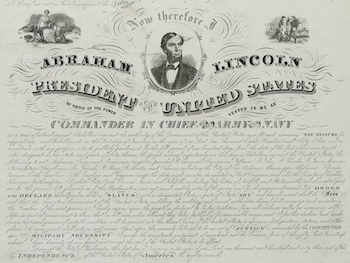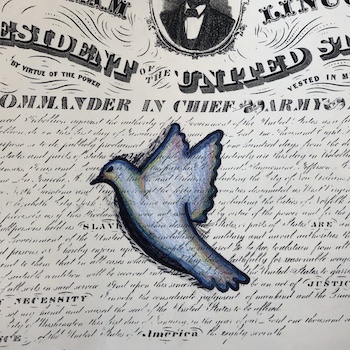SUBJECTS
GRADE
Show Results
Symbols of Freedom

Lesson Summary
- Consider elements of the Emancipation Proclamation and the history of broadsides.
- Learn about symbols and shading.
- Draw freedom symbols onto a copy of the Emancipation Proclamation.
Lesson Plan and Procedure
Lesson Key Facts
- Grade(s): 5
- Subject(s): Social Studies, Visual Arts
- Duration of lesson: Two or three sessions, 45 minutes each
- Author(s): Christine Palmer
Introduction: The Emancipation Proclamation
This is a supplemental lesson to complement a unit study of the Civil War. Students should have knowledge about the events leading up to the signing of the Emancipation Proclamation prior to the studio activity. Consider showing students this short video about the Emancipation Proclamation provided by the Henry Ford Museum and PBS: https://www.pbs.org/video/american-black-journal-look-emancipation-proclamation/.
After discussing the significance of the Emancipation Proclamation, lead a discussion about simple freedoms that students enjoy in their own lives.
Preparation
Print out a black-and-white copy of the Emancipation Proclamation broadside for each student. You will also need to print out example images of freedom symbols. These will be used as drawing references. You can find photographs or clip-art images from Google.
Studio Activity: Broadsides and Symbols of Freedom
 Teacher: Broadsides are single-sheet documents that are printed on only one side. They originated in Europe right after the printing press was invented. They were smaller than a poster and originally contained no pictures or illustrations. They were primarily a means to get information out to people quickly. The most famous broadside published in America was printed on July fourth and fifth, 1776. . . . Who can guess what that was? The Declaration of Independence! The broadside later split into two main categories: (1) news and (2) posters/advertisements.
Teacher: Broadsides are single-sheet documents that are printed on only one side. They originated in Europe right after the printing press was invented. They were smaller than a poster and originally contained no pictures or illustrations. They were primarily a means to get information out to people quickly. The most famous broadside published in America was printed on July fourth and fifth, 1776. . . . Who can guess what that was? The Declaration of Independence! The broadside later split into two main categories: (1) news and (2) posters/advertisements.
Ask students to think of a poster they would hang in their room. Let some students respond. Explain that their poster examples originated with broadsides.
Show students the following image. See the section “Equipment and Materials Needed” for the link to a higher-resolution image.
Teacher: This is a broadside of the Emancipation Proclamation. This broadside is not what the original Emancipation Proclamation looked like. The original document had no illustrations or pictures. This broadside was created over a year later than the original by an artist who wanted to make it look nicer so that people could hang it in their offices and homes to commemorate it (that means to celebrate it or show it off). Each of you will get a copy of this broadside and draw symbols of freedom with colored pencils atop it.
Symbols of Freedom
Teacher: What are some symbols that represent freedom to you?
Discuss the symbols with students. The following symbols may be brought up, among others: the Statue of Liberty, doves, chains or handcuffs breaking, the American flag, the Liberty Bell, bald eagles, torches, fireworks, the Lincoln Memorial, Uncle Sam, and freedom quilts. Some students may come up with abstract examples of freedom as well.
Talk about how some of these symbols are artwork that was used to influence people to change or impact their values and beliefs.
Teacher: Let’s look at this Uncle Sam poster. It’s a lot like a broadside.
Show the I Want You poster by James Montgomery Flagg:

Teacher: This poster was used during World War I and World War II to urge young men to join the army. The man in this picture is known as Uncle Sam, an iconic image that represents the United States government. Millions of American men responded to Uncle Sam’s call to serve in the war. This image was used again and again and became so popular that many Americans still recognize it to this day. How do you think this poster changed the beliefs or values of Americans? How do you think this image represents freedom?
Instruct the students to pick one or more symbols that represent freedom to them. If students have easy access to computers, you could have them find their own reference images. Remind the students that they will be drawing the symbols directly onto a broadside copy of the Emancipation Proclamation. You may want them to practice drawing the symbols on scratch paper or in their sketchbooks, if they have them.
Drawing Using Shading
Give students the opportunity to work from the freedom image printouts if they need to. Tell students not to copy  or trace these images but to use them as a reference for their own drawings.
or trace these images but to use them as a reference for their own drawings.
Have students draw symbols very lightly with pencil on top of the broadside copy. Warn students that erasing their pencil marks will also erase the words on the document. Encourage students to draw big! And if they desire, they can outline with black marker so that the image stands out against the background.
Once their pencil outline is drawn, the students are ready to add color and value with colored pencils. Explain what value is and how students can create lighter and darker values with their colored pencils by pressing harder or lighter. Demonstrate a quick value scale and allow students to practice making different values with their pencils on a scratch piece of paper. For more information on value, value scales, and shading with colored pencils, watch the following videos in the links below.
https://www.youtube.com/watch?v=-DDTrpJ4PXg
https://www.youtube.com/watch?v=AAwYHNo31ZQ&t=98s
https://www.youtube.com/watch?v=wchtknP-xoo
 To create a three-dimensional look, students can shade (add darker color) around the edges of a form and create a highlight (light spot) in the center.
To create a three-dimensional look, students can shade (add darker color) around the edges of a form and create a highlight (light spot) in the center.
They can also overlap and layer other colors to create new colors. Notice the yellows, blues, and reds layered, as well as the nice highlight in the fifth-grade example.
Learning Objectives
- Explain the content and purpose of the Emancipation Proclamation.
- Identify and analyze cultural associations suggested by visual imagery.
- Identify how art is used to inform or change beliefs, values, or behaviors.
Utah State Board of Education Standards
This lesson can be used to meet standards in many grades and subject areas. We will highlight one grade’s standards to give an example of application.
Grade 5 Social Studies
Standard 5.4.7: Identify the Civil War’s most important outcomes (for example, end of slavery, Reconstruction, expanded role of the federal government, industrial growth in the North), and explain how outcomes of the Civil War continue to resonate today.
Grade 5 Visual Arts
Strand RESPOND (5.V.R.): Students will understand, evaluate, and articulate how works of art convey meaning for the observer as well as the creator (Standards 5.V.R.1-2).
Standard 5.V.R.2: Identify and analyze cultural associations suggested by visual imagery.
Strand CONNECT (5.V.CO.): Students will relate artistic skills, ideas, and work with personal meaning and external context (Standards 5.V.CO.1-2).
Standard 5.V.CO.2: Identify how art is used to inform or change beliefs, values, or behaviors of an individual or society.
Equipment and Materials Needed
- Link to high-resolution copy of broadside
- I Want You poster by James Montgomery Flagg
- Student copies of the Emancipation Proclamation broadside by Charles Shober
- Examples of symbols of freedom (Google search/clip art)
- Pencils and colored pencils
- Black markers
Additional Resources
- Educational video about the Emancipation Proclamation: https://www.pbs.org/video/american-black-journal-look-emancipation-proclamation/
- Educational video about shading: https://www.youtube.com/watch?v=-DDTrpJ4PXg
- Educational video about value: https://www.youtube.com/watch?v=AAwYHNo31ZQ&t=98s
- Educational video about colored pencils: https://www.youtube.com/watch?v=wchtknP-xoo
Image References
Image 1: Christine Palmer.
Image 2: https://commons.wikimedia.org/wiki/File:Emancipation_Proclamation.jpg
Image 3: https://commons.wikimedia.org/wiki/File:Unclesamwantyou.jpg - filelinks
Image 4-5: Christine Palmer.

www.education.byu.edu/arts/lessons
 Download
Download